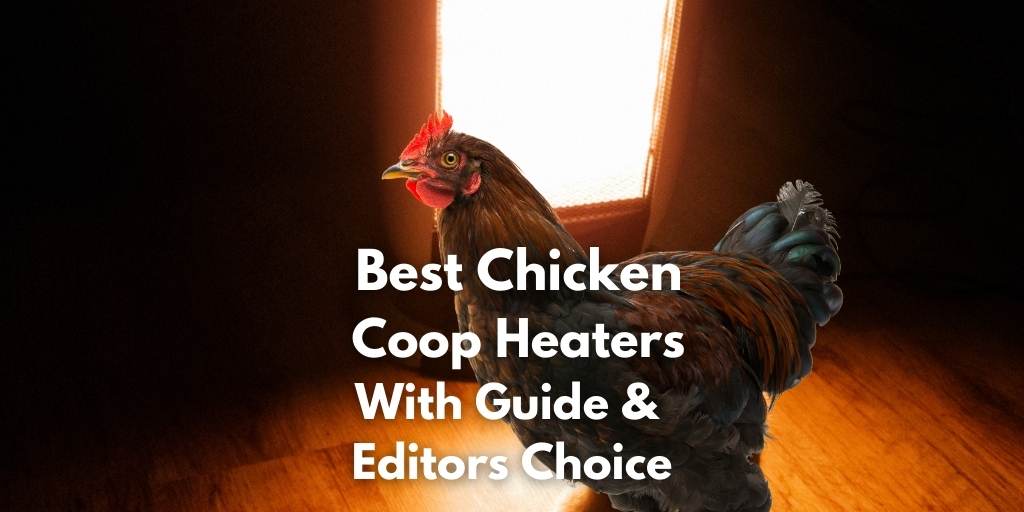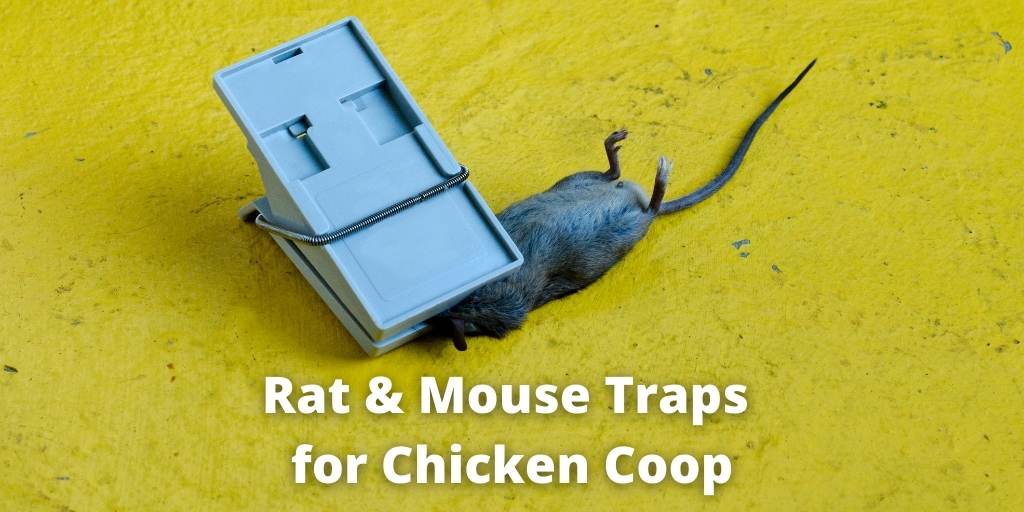Every chicken coop needs a quality roof. It shields chickens from harsh climates and predators.
The roof affects airflow and temperature inside the coop, vital for chicken well-being. Coop roofs vary in design and materials to suit different climates, budgets, and aesthetics.
This article explores chicken coop roofing. We examine roof styles from simple and complicated designs. We discuss roofing materials like asphalt shingles, metal, and wood blocks.
Key factors like climate, cost, and appearance determine the ideal roof choice. The guide provides installation tips, maintenance advice, and add-on features to enhance functionality. You’ll also find design inspiration for creative coop roofs.
After reading, you’ll know how to choose a roof perfectly suited for your coop. Your chickens will enjoy a safe, comfortable, long-lasting home with the proper roofing.
So let’s get started on learning all about chicken coop roofs! From practical considerations to creative expressions, this comprehensive guide covers every aspect.
Because of this, you’ll be able to build the perfect roof for your chicken coop.
Also read: Top 15 Best Pre-made Chicken Coops
Importance of a Good Quality Chicken Coop Roof
A high-quality roof isn’t just a nice feature for your chicken coop – it’s vital for your flock’s safety, health, and long-term investment!
Keep Safe From Predators
Chickens face a wide array of predators depending on your location. Foxes, raccoons, weasels, owls, hawks, and neighborhood dogs can all pose a threat.
A flimsy roof is no match for determined claws, teeth, or beaks. Predators can rip through weak materials, tear off shingles, or even find gaps to squeeze through.
A sturdy, well-sealed roof distinguishes between a safe flock and tragedy. Invest in materials that match the predators in your area.
Protection From Weather
Chickens may be hardy, but they’re not immune to the weather. A good roof provides rain shelter.
A leaky roof leads to a wet, muddy coop, which breeds bacteria and can chill your chickens, leading to illness.
Chickens can overheat, especially dark-feathered breeds. Shade is crucial during the hot summer months, which can be done by a wood roof with ventilation.
A strong roof supports the weight of snow without collapsing. This is especially vital in colder climates.
High winds can damage poorly constructed roofs, leaving your flock exposed. A solid structure keeps them safe.
Promoting Well-being
Poor ventilation due to a solid roof without openings leads to stagnant air, ammonia buildup from droppings, and increased humidity. This is a recipe for respiratory illnesses.
Ventilation on chicken coop roofs, like ridge vents or small windows, promotes airflow. This keeps your chickens healthier and happier.
Long-Term Investment
Flimsy, low-quality chicken coop roofs require constant repairs or replacements after weather damage or predator attacks. Spending money and time becomes a hassle.
Investing upfront in durable, weather-resistant roof materials and construction pays off. Your roof lasts longer, shielding the coop structure from water rot.
Also read: Build a Predator Proof Chicken Coop (Complete Guide)
Types of Chicken Coop Roofs (Examples and Ideas)
Below are the best types of chicken coop roofs that give you ideas to build one for your chickens:
1. Simple Flat Design

When constructing chicken coops, flat roofs offer a straightforward and cost-effective design approach.
Flat chicken coop roofs consist of a level surface supported by underlying beams, making them relatively easy to construct for DIY enthusiasts compared to slanted roofs.
The absence of a slope maximizes interior headroom within the coop, potentially accommodating taller chicken breeds comfortably.
The flat surface can be utilized for installing solar panels, rainwater collection systems, or even establishing a rooftop herb garden (proper coop ventilation must be ensured for such modifications).
The primary drawback of flat roofs is their potential for poor drainage. Standing water can lead to leaks, rot, and attract mosquitoes.
Flat roofs face challenges when substantial snowfall accumulates. The substantial weight of compacted snow poses a risk, potentially leading to structural collapse.
These designs can trap heat within the coop’s interior, especially in warm climates. Ensuring adequate airflow through strategically positioned vents is crucial to prevent overheating.
Therefore, clearing debris accumulation and detecting potential leaks can prove more challenging due to the roof’s flat surface.
2. Open Gable Type Roof

An open gable roof chicken coop roof has two sloping sides that meet at the top. It forms a triangle shape on each end.
It is sturdy and strong. The triangular shape provides excellent support. This helps the coop withstand wind, rain, snow, and animals trying to climb on top.
It allows great airflow inside the coop. Warm air rises and exits through vents near the top.
This creates a “chimney effect”. Fresh air enters through lower vents. This continuous air exchange is good.
If vents are on opposite sides, it creates cross-ventilation. Fresh air enters from one side. Stale air exits from the other side.
The full height on one side provides ample headroom inside the coop. Some chicken breeds are larger. They need more vertical space to move around comfortably.
A gable roof lets you build high perches inside for chickens’ night roosting. This lets chickens roost like they do in nature.
Predators look for coops where chickens can’t move around much. A gable roof with more headroom makes it harder for predators to reach the chickens if they get inside.
They’re simple to build, even if you’re not great at carpentry. The structure is very sturdy and strong.
They need more wood for the rafters and ridge beam than a lean-to roof. This costs more.
In snowy areas, snow piles up on the sloped sides. You’ll need to clear it off.
3. Shed Type Roof
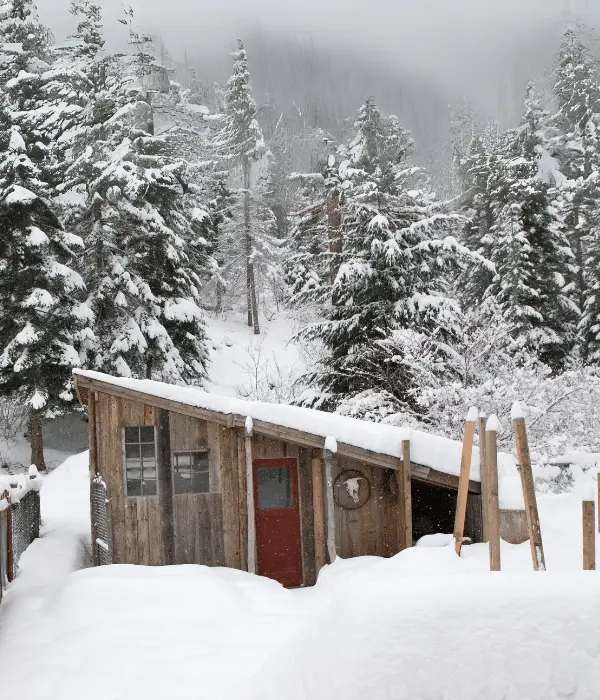
The shed chicken coop roofs have one sloped side. One side is higher than the other. Shed roofs are simple to build. They are great for do-it-yourself projects.
These roofs need less wood and roofing material than complex roof types. Shed roofs work well in many climates:
The slope allows rain to easily run off. This prevents leaks and water buildup.
Shed roofs can handle some snow. For heavy snow, a steeper slope helps snow slide off.
Proper ventilation is important. Shed roofs can trap heat inside the coop. Adding vents helps airflow.
The shed roofs have very little headspace. Consider this for tall and large chicken breeds or storage needs.
Shed-type chicken coop roofs are useful, but not very decorative compared to other roof styles.
In windy areas, securely anchor the roof. Position the higher side away from strong winds.
Adding an extra piece of roof that sticks out on the low side can help keep the coop entrance dry in the rain.
The best amount of tilt for the roof is essential, depending on how much rain and snow falls in your area.
4. A-Frame Type Roof
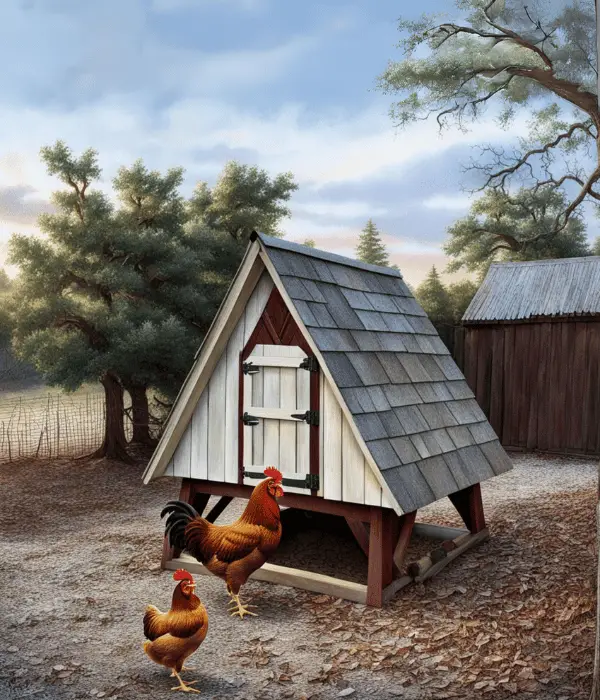
The A-frame roof is a common design. It looks like an upside-down “V.” This is often seen in traditional cabins and sheds. A-frame roofs work well for chicken coops too.
Two slopes meet at the top. This creates a steep angle on both sides. This is the main feature of this type of chicken coop roof.
The steep slopes allow water and snow to slide off quickly. Rain doesn’t pool, reducing leaks. Snow doesn’t build up and damage the roof.
The triangle shape makes the roof very sturdy. A-frame roofs can handle strong winds and heavy snow.
The angled design typically provides a good headroom in the middle of the coop. This gives space for taller chicken breeds or storage.
Compared to easier roof styles like shed roofs, A-frame roofs need more exact cutting and assembly due to the angled slopes. Making one might be harder for those without much DIY know-how.
A-frame roofs use more building supplies compared to flat or shed roofs. This could make the full cost higher.
The slanting sides of the A-frame can limit how much usable wall space is inside the coop, especially near the edges.
5. Round Design Roof

Round roofs for chicken coops look cool and unique. But before you build one, think about the good and bad things.
This type of roof gives your coop a fun, different look that stands out. The round shape can save space in small yards.
You can add skylights or windows to let in natural light. Round roofs may struggle with certain weather conditions.
Light rain isn’t too bad, but you’ll need a slope or gutters for better drainage.
Moderate snow is okay, but heavy snow can pile up in the middle and get too heavy.
Another most important thing is it takes special skills and tools to build one. Ready-made kits are difficult to find.
Not all roofing materials come pre-cut for round shapes, limiting your options and maybe costing more.
Water can collect on round roofs if not built correctly. This pooling of water can cause leaks and harm the structure.
Round roofs may trap heat and moisture inside. Proper vents allow airflow to prevent this from happening.
6. Gambrel Roof
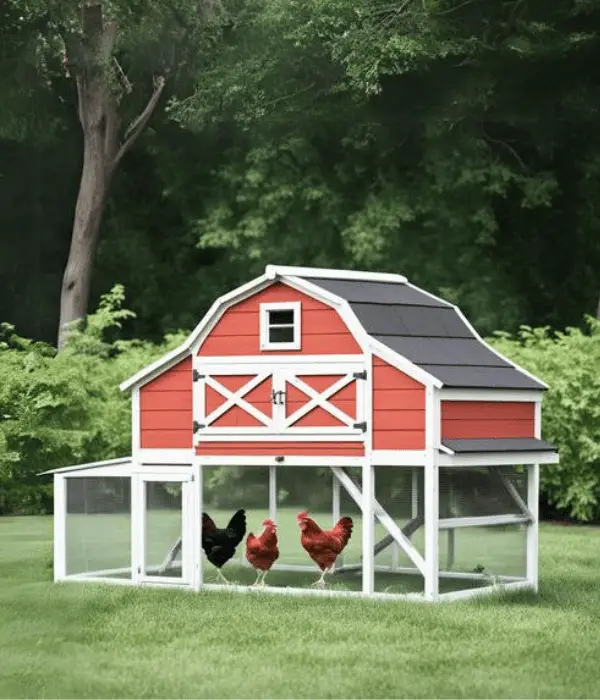
Gambrel roofs have a unique barn-like design that’s becoming popular for chicken coops.
A gambrel roof features two slopes on each side. The top slope is gentle, while the bottom slope is much steeper.
It resembles an old-fashioned barn. This design maximizes headroom and usable space in the coop’s center while keeping a reasonable overall height.
Many find the classic barn style visually appealing. If tall enough, the central space created by a gambrel roof could be used as a storage loft for feed, bedding, or supplies.
The main benefit is extra interior space. This allows for more chickens, larger roosting bars, and vertical features like hanging feeders.
While not as efficient as an open gable, the upper slopes still promote some airflow, helping regulate temperature and humidity.
The steep lower roof parts let rain and snow fall off easily. This prevents leaks and stops heavy snow from building up on the roof.
Gambrel roofs need more planning and work than basic gable or lean-to roofs. They may not suit beginner DIYers.
The multi-slope design uses more wood and roofing stuff, making construction more expensive.
In very windy areas, gambrel roofs with their bigger surface could get damaged by high winds, especially the steep lower slopes.
Weigh the extra inside space against the higher difficulty and costs compared to other roof types.
7. Mansard Type Roof
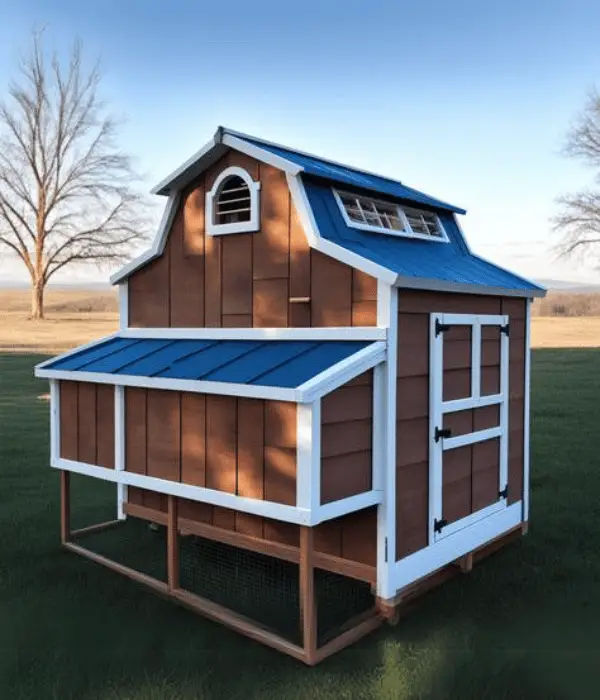
Mansard roofs are not a common choice for chicken coops. A mansard roof has four sloping sides.
The lower slopes are very steep, almost vertical. The upper slopes are gently angled. This creates a boxy shape with a flat top.
Mansard roofs are often seen in traditional French architecture. They are among the most intricate to build because of their extensive framing and joinery.
This makes them time-consuming and expensive, especially for a small structure like a coop.
The design limits natural airflow. Good ventilation is crucial in coops. Without it, moisture and gases can quickly accumulate. This can harm the chickens’ respiratory health.
While mansard roofs maximize interior space, this extra space comes at a premium due to their complexity.
Simpler roof designs can still provide ample space for most flocks. The flat top tends to retain heat, making the coop warmer in summer.
If purely for aesthetics, a mansard roof coop would certainly stand out. If designed with sufficient height, the central attic-like space created by a mansard roof could be somewhat usable for light storage.
8. Thatched Roof
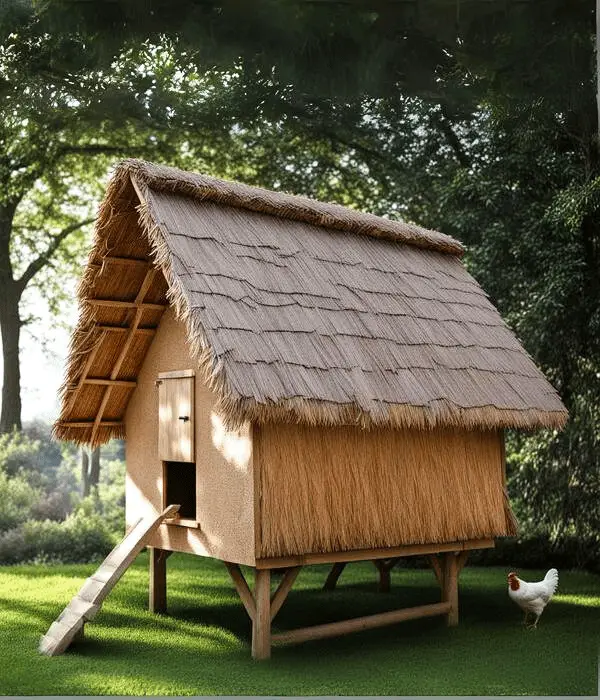
Thatched roofs are not very popular for coops. They are made by layering dried plants or parts like straw, reeds, or water reed in thick bundles.
These thatched roofs were common in rural areas where these plants were easily available.
These types of roofs are not a popular choice for modern chicken coops. Thatching roofs requires special skills.
The materials and labor costs can be much higher than regular roofing like metal or shingles.
Also thatched roofs need regular upkeep, including repairs and re-thatching as the materials degrade over time.
Another risk factor is the flammable dry tatch which increases the risk of fire compared to non-flammable roof options.
Thatch is an excellent natural insulator, keeping the coop cool in summer and warm in winter.
Thatched roofs have a charming rustic look, appealing to those wanting a unique and visually attractive coop.
Also, the materials are natural and sustainable, especially if sourced locally.
The natural materials in a thatched roof can attract insects, birds, and rodents, posing potential health risks to your chickens.
Risks of fire, pest infestations, and potential mold growth in a thatched roof can create an unhealthy environment for your chickens.
Materials For Chicken Coop Roofs
Here is the list of the right materials for building a chicken coop roof:
1. Metal Roofing
Chicken coops have metal roofing. It protects chickens well. Metal roofing is strong and easy to keep up.
Metal roofing uses metal sheets on roofs. There are available in different types:
- Corrugated Metal which has wavy lines. It’s easy to install.
- Standing Seam Metal has panels sealed together.
- Galvanized Steel resists rust. Moreover, it is affordable.
- Aluminum is light and rust-proof but costs more.
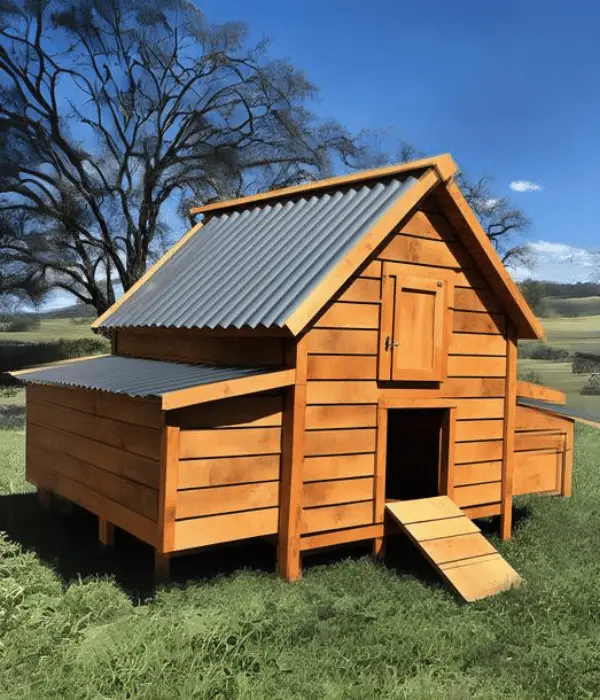
Metal roofs are great for chicken coops because they last very long. They can survive easily in heavy rain, snow, wind, and hail.
They hardly need fixing. Just requires cleaning and painting occasionally. Metal roofs go for decades. So, they save money over time.
Metal is good for coops because it won’t burn and is also light in weight. It won’t attract small animals like rats.
In rainy areas, water slides off easily from metal chicken coop roofs and helps in stopping leaks.
Also in snowy areas, the strong metals easily hold the snow. It is also good for hot climate areas, but you need to put reflective vinyl paint to keep the coop cool.
Metal coop roofs cost more to start than shingles or wood. This type of roof can get loud during heavy rains.
This may disturb your chickens or neighbors. Adding insulation can reduce noise.
Metal roofs may have condensation issues in cold areas. Proper ventilation is key to avoid moisture buildup and coop rot.
Cutting and installing metal roofs requires specific tools and skills. Consider hiring a professional roofer if you’re not experienced with DIY projects.
Metal roofs become slippery in wet conditions. This makes it hard for people or predators to access the roof.
- 【High-Quality Material】: Our Roof Panels are made...
- 【Specification】: Dimensions/Per Pieces: 60.63" x...
- 【Aesthetic Look】: These roofing panels are...
- 【Package Contents】: Each package includes 20 pieces...
- 【Versatile Usage】: The panels protection make an...
Last update on 2025-07-02 / Affiliate links / Images from Amazon Product Advertising API
2. Corrugated Roofing
Corrugated roofs are a smart choice for chicken coops. They’re affordable and keep your chickens safe.
These roofs have wavy metal or plastic sheets. The ridges make them sturdy and let the water run.
Metal corrugated roofs are durable, weather-resistant, and made of steel or aluminum. Plastic corrugated roofs are cheaper but not as tough.
Corrugated roofs are affordable. They’re lightweight, easy to install, and available everywhere. Metal corrugated roofs are durable too.
Lightweight corrugated sheets are easy to work with. Sold at hardware stores. Metal ones withstand rain, snow, and wind.
Corrugated chicken coop roofs work well in mild rain and snowfall areas. Both metal or plastic corrugated roofs work in dry, desert-like places. These are budget-friendly options for temporary chicken shelters.
3. Polycarbonate Roofing
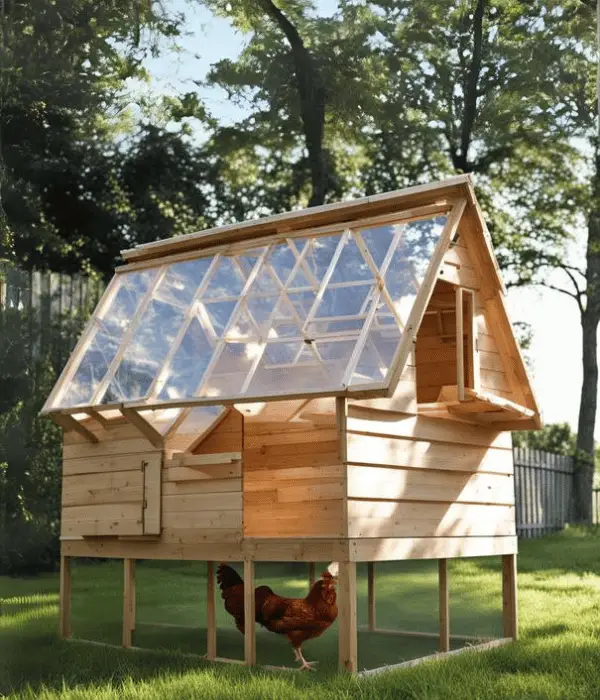
Polycarbonate roofing is a strong plastic coop roof made of thermoplastic. It’s clear or tinted and very tough.
This type of roofing is common in chicken coops as corrugated sheets or flat panels.
Corrugated polycarbonate sheets are in wavy shape, and look like metal roofs. They are strong and easy to set up.
Flat polycarbonate panels have a smooth look. You can cut them according to your needs.
Natural light can pass through the plastic roof in sunlight, which brightens the coop.
It’s super tough and won’t shatter from hail, branches, etc. Moreover, the lightweight panels are DIY-friendly.
Polycarbonate roofs come in different shades to customize the coop. It blocks UV rays and diffuses light nicely.
This is strong enough for moderate rain and snow. Water slides off it easily. Its impact resistance makes it a smart choice where hail is common.
But polycarbonate roofing also has some downsides: It can be pricier than corrugated metal or plastic roofing.
Some lower-quality polycarbonate sheets may yellow or get hazy from UV exposure. Look for sheets with good UV coatings.
In very cold temps, polycarbonate can get brittle. In extreme heat, it may collapse.
While polycarbonate lets in light, make sure your coop has good airflow to avoid overheating, especially in warm areas.
- Use as an under-deck drip-stop, deck roofing, patio...
- Easy to install with household tools (tools not...
- Great light transmission and clarity
- Polycarbonate Roofing Panel, Curved, in Clear 21" W x...
Last update on 2025-07-02 / Affiliate links / Images from Amazon Product Advertising API
4. Shingle Roofing
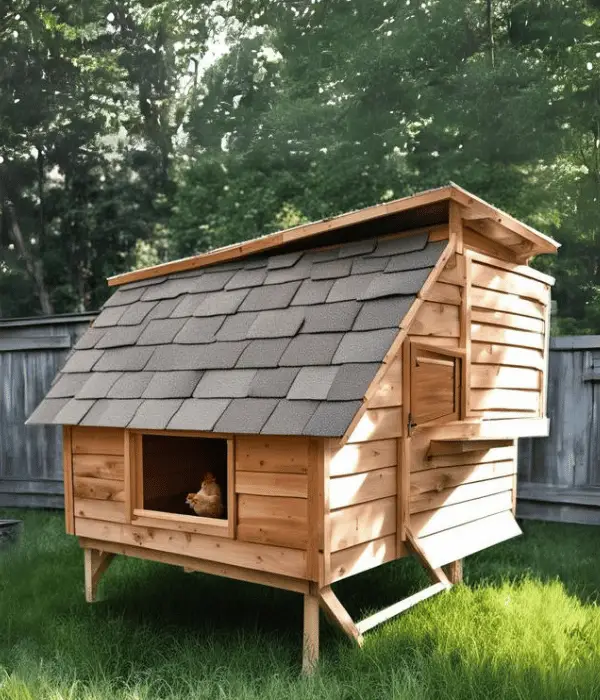
Shingles are a common roof material used for homes and chicken coop.
Shingles come in different materials. Asphalt shingles are the most affordable choice for coops. Here are common types:
Asphalt shingles are made of fiberglass with asphalt and ceramic granules. They’re weatherproof and cheap.
Metal shingles are made of lightweight metal, which are very durable and costly.
Wood Shingles are traditional and nice-looking. But needs more upkeep. Can rot or get bugs.
Good asphalt shingles last for about 15–20 years or more with proper installation and care. Asphalt shingles roof protect well against rain, snow, and wind.
Asphalt shingles are more fire-resistant, especially compared to wood roofing materials.
But they are more pricey than metal or plastic roofs. It can crack or degrade over time, requiring fixes or replacement.
Heavier, so the coop frame must support it. Not ideal for tiny coops due to installation challenges and material waste.
5. Asbestos Roofing
Asbestos roofing for a chicken coop is extremely hazardous. It is a mineral made of tiny fibers.
It was used in buildings as it resists fire and insulates well. But asbestos can cause severe health issues.
This may cause mesothelioma like aggressive cancer in the lung lining, chest, abdomen, or heart.
Over time, asbestos fibers become brittle and released into the air. When inhaled, these fibers embed in the lungs, causing harm. In a coop, both chickens and owners risk exposure.
Chickens can inhale fibers from dust or scratching. Owners risk exposure during cleaning and maintenance.
If your coop has asbestos roofing, have experts remove it safely. Contact certified asbestos removal firms. Don’t remove asbestos yourself.
Keep your chickens and yourself safe. Use readily available, safe roofing for peace of mind.
6. Wood Roofing
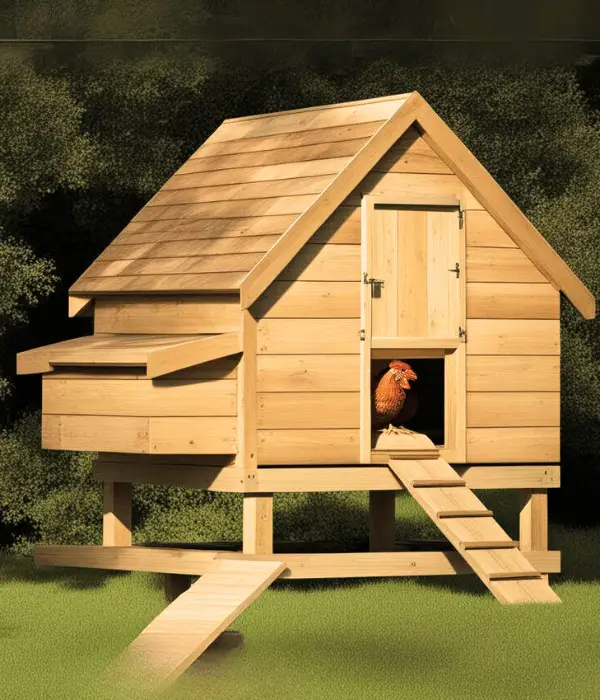
Wooden roofing offers a rustic appeal to your chicken coops. This material comprises layered wood shingles like cedar, pine, or redwood fastened to the roof structure.
The wood roof has natural beauty. They are visually appealing, blending with natural settings.
Wooden roofing helps in regulating the coop’s inside temperature. Not only this, it provided good ventilation inside the coop.
Wood performs optimally with minimal rainfall and humidity, preventing rot. You must paint the outer and inner parts of the chicken coop roof with good quality weatherproof paint.
They require regular inspection, cleaning, and potential re-sealing to maintain their weatherproofing and prevent rot.
Wood roofs and coops are susceptible to moisture damage, rot, and insect infestation if not properly maintained.
Moreover, it is a flammable material, posing a fire hazard compared to metal or metal roofing.
Compared to metal roofing, wood has a shorter lifespan and may require replacement sooner.
Wood roofing can be heavy, adding stress to the coop structure. Ensure the coop frame can support the weight.
Using pressure-treated wood or applying a high-quality wood sealant can enhance durability and moisture resistance.
7. Cloth/Tarp Sheet Roofing
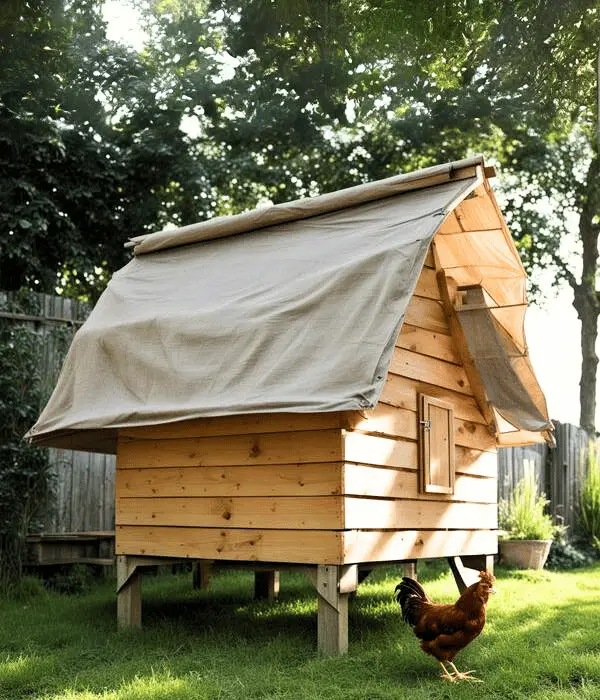
Cloth or tarp sheets aren’t recommended for permanent chicken coop roofing. They’re affordable, but not suitable for roofs.
Tarps are best for use to cover the side netting of the chicken sheds or coops to avoid getting rainwater during heavy rainfall.
They may long last but are not suitable for most weather conditions. It can handle light rain but not cyclonic storms, snowfall, and heavy rainfall.
You may face problems like leaks, tears, and sag. They offers minimal insulation, making coops too hot or cold.
Sun and weather quickly damage them, needing frequent replacements. Chickens can peck holes, allowing predators entry or their escape.
Depending on the material, cloth/tarps can be flammable fire hazards. So, it is better to go with a plastic chicken coop roof, which is better in both cost and quality than tarps.-
Considerations for Choosing the Right Roof Material
Key factors for picking a solid chicken coop roof:
1. Durability
When building your chickens’ home, a durable roof is super important. It’ll protect your feathery friends for years.
Use the stuff that lets water roll right off. And if you get snow, make sure it can hold the weight.
Build it sturdy so high winds and flying debris don’t wreck it. Grab UV-resistant materials or add a protective coat, so the sun doesn’t break it down.
Nasty critters might try chewing or scratching their way in. Use tough stuff they can’t get through and secure it tight.
They might roost on the roof or peck at it. Use materials they can’t easily damage, and design it so they’re less likely to hang out up there.
Even the best stuff wears out eventually. Get long-lasting materials and do regular check-ups and repairs when needed.
Material Selection:
- Metal: Crazy durable and won’t let weather or predators ruin it. Corrugated is affordable, but standing seam is even stronger.
- Polycarbonate: Shatter-resistant, blocks UV rays, and is lighter than glass.
- Treated Wood: Pressure-treating helps it resist rot and bugs way better than regular untreated wood.
- Asphalt Shingles: They provide solid protection for bigger coops, offering a classic look.
Design:
- Sloped roofs let water, and snow slide off, reducing weight and rot issues.
- Overhangs shield walls from driving rain and offer shade when hot.
- Use sturdy wire mesh under the roof for extra predator protection.
Construction:
- Use robust lumber sizes, and proper spacing to support roof weight and winds.
- Weather-appropriate screws, nails, bolts: secure roofing materials tightly.
- Install waterproof underlayment under shingles/metal for moisture protection.
Maintenance:
- Regularly inspect for damage, leaks, and loose fasteners. Fix promptly.
- Reapply sealants, and paint for wood/metal roofs to extend lifespan.
- Clear debris like branches, and leaves to prevent buildup and moisture damage.
Balance Durability With Other Factors
Durable metals cost more upfront but offer long-term value via low maintenance, and lifespan.
In harsh climates, invest in the strongest materials, despite slightly higher costs.
Style: If it looks matter, pick materials that mix sturdiness with your desired design.
2. Weather Resistance
Building a weather-resistant chicken coop roof is vital for shielding your birds from rain, snow, wind, and harsh sun.
Know Your Local Weather Challenges:
- Rainfall: Find out your area’s average rainfall – heavy downpours or showers.
- Snow Load: Know the expected snowfall weight the roof needs to bear.
- Wind: Assess typical wind speeds and potential gusts or storms.
- Sunlight: Consider the sun’s intensity and how hot your roof might get.
- Temperature Extremes: Factor in winter chills if you need insulation under the roof.
Roof Design:
- Sloped Roofs: A sloped roof is vital for shedding water and snow. Options like shed, A-frame, or gable roofs. Steeper pitch = faster water/snow runoff.
- Overhangs: Extending your roof with an overhang shields coop walls from direct rain and provides shade for your birds in hot weather.
- Material Choices:
- Metal Roofing: It is highly weather-resistant, and handles heavy rain, snow, and strong winds well.
- Polycarbonate Roofing: Impact-resistant, sheds water, and offers UV protection for sunny regions.
- Shingle Roofing: Provides good weather protection, but ensure you pick durable shingles suited to your climate.
- Corrugated Plastic: Budget-friendly and suitable for mild weather, but choose UV-treated plastic for extended durability in sunny regions.
Construction Techniques:
- Sturdy Framing: Ensure the roof frame is strong enough to withstand snow load and wind gusts without collapsing.
- Quality Fasteners: Use galvanized or stainless steel screws and nails to prevent rust and ensure a secure hold in all weather conditions.
- Proper Sealing: Seal any gaps or seams where water or wind could penetrate. Use caulk and flashing as needed.
3. Insulation
Insulation prevents heat loss in freezing winters, keeping chickens warmer. Roof insulation reflects sun’s rays, cooling the coop in scorching summers.
If temperatures swing between hot and cold in your locality, roof insulation keeps it cozy for your chickens year-round.
Insulation Types:
- Rigid foam boards easily fit between rafters. Great insulation.
- Fiberglass batts are common and cheap but need a moisture barrier.
- Spray foam insulates well and seals gaps, but needs a pro.
- Reflective insulation helps keep cool in hot climates by reflecting sunlight.
Installing Insulation
- Put insulation between rafters, and under roof sheathing.
- With fiberglass, add a vapor barrier on the inside to stop moisture damage.
- Cover insulation with plywood or panels, so chickens don’t peck it.
Other Insulation Tips
- Ventilation is still key for airflow and keeping things dry.
- Choose water-resistant insulation that won’t let rain in. Seal gaps properly.
- Colder zones require more insulation for cozy chickens.
- Bigger coops lose heat faster, so insulate wisely.
- Some chicken breeds are built for chilly nights.
4. Cost
Building a coop roof balances cost with durability, weather protection, and style.
Understand if the upfront cost is high, you will get a strong chicken coop roof. Less maintain.
- Plastic sheets: Cheap short term. Not as sturdy.
- Polycarbonate: Mid-price. Solid and see-through.
- Shingle Roofs: Rates differ. Asphalt decent price.
- Metal roofs: Pricey but sturdy.
A few Other Tips For Cost-Saving
Design: Simple plans cheaper. Less framing things. Complex angles need more stuff. Take more effort. Bigger roofs cost extra materials. DIY saves fees, versus contractors.
Save Money Roofing: Compare prices first. The upfront cost isn’t all – good roofs last ages with small upkeep.
Reuse stuff: Used metal or wood in your backyard. okay, if in good shape. Look for sales at hardware stores. Buy extra stuff cheap.
Pick Simple Roof Styles: A shed or A-frame roof is easy to build and costs less. If DIY isn’t your thing, go simple to avoid paying for help on complex roofs.
Balance Cost vs. Needs: Prioritize essential features like durability in harsh climates or good looks.
Consider Long-Term Value: A pricier but sturdy roof may save money over replacing cheap options repeatedly.
5. Maintenance
Thinking ahead about upkeep can save you big-time effort and cash for your chicken coop’s roof.
Metal Roofing: Built to last, with just a bit of cleaning and checking for loose screws, needed now and then.
Corrugated Plastic: Needs washing regularly and may need replacing due to sun damage or storms.
Polycarbonate Roofing: Give it a wipe-down and check for yellowing or scratches occasionally.
Shingles: Keep an eye out for any missing or busted ones, maybe re-seal over time too.
Wood: Highest upkeep – inspect for rot, repaint or reseal, and possibly replace damaged parts.
How to Put a Roof on Your Chicken Coop?
Here is a step-by-step guide to adding a beautiful and sturdy roof to your chicken coop:
Follow These Easy Steps to Roof Your Coop
Prepare Work
- Pick a style (shed, A-frame, etc.). Consider the climate in your area.
- Calculate supplies needed (wood, roofing, hardware).
- Gather tools like saws, drills, safety gear, etc.
Build the Frame
- Construct rafters per design.
- Secure rafters to walls. Level the base.
- Add ridge board if needed for support.
- Install sheathing if required by roofing material.
Roof Installation
- If you’re using shingles, put down a waterproof underlayment.
- Install metal, polycarbonate, shingles, etc. per instruction.
- Seal seams, edges, vents. Add flashing around leaks.
Extras
- Consider adding gutters to manage rain runoff.
- Proper airflow is key. Install ridge, gable vents, or little windows.
Keep That Coop Roof in Tip-Top Shape:
Check twice yearly (before winter and post-storms) for red flags
- Change damaged or missing roofing bits.
- Check and close leaks or water damage signs.
- Loose fasteners wearing down.
- Check for algae, moss, or debris buildup.
- Clear out leaves/branches regularly.
- Clean gutters to avoid clogs/overflow.
- Gently scrub dirt or algae off the roof.
Fix these asap
- Replace damaged/missing shingles or panels.
- Reseal cracks, gaps in the roof, or flashing.
- Tighten loose fasteners, replace corroded ones.
- Address wood rot or pest issues stat.
Maintain
- Reapply sealants/paint for wood roofs.
- Consider recoating worn metal roofs.
Other tips
- Safety first – have a buddy, and follow ladder/tool protocols.
- Check local building codes before construction.
- Assess skills honestly – call pros if needed.
FAQ and Common Concerns
Do Chicken Coops Need Roofs?
Roofs safeguard chickens from harsh weather like rain, snow, and scorching sun. A sturdy roof prevents flooding, keeps interiors dry, and provides a secure refuge.
Moreover, roofs defend against predators, including airborne threats like hawks, and ground-based ones like raccoons.
With a robust, gap-free coop roof, your flock has a safe haven. Roofs also promote coop hygiene by keeping droppings, food, and bedding dry, minimizing mold and bacterial growth that could harm your chickens.
How Often Should Chicken Coop Roofs Be Cleaned?
Routinely remove leaves, branches, and debris buildup, particularly after storms, to prevent damage and ensure proper water runoff.
In damp climates, scrape off moss or algae growth, as these can trap moisture against the roof material, accelerating wear.
Additionally, clean installed gutters regularly to prevent clogs, as overflowing gutters can damage coop walls or foundations.
Can Chicken Coops Have Dirt Floors?
Dirt floors allow chickens to engage in natural behaviors like dust bathing and scratching, and are initially cost-effective as no bedding is required.
However, dirt floors can become muddy and unsanitary, especially in rainy climates, and removing waste can be labor-intensive.
They also makes the coop vulnerable to predators that can burrow under unless the perimeter is deeply secured.
Do Chicken Coops Need Insulation?
Insulating chicken coops offers advantages in severe climates. It keeps chickens comfortable when it’s cold or hot outside by maintaining a stable interior temperature.
Insulation is particularly helpful for cold-sensitive breeds and areas with drastic seasonal temperature changes.
Can Chicken Coops Be Too Big?
Large chicken coops have potential drawbacks. They are challenging to heat efficiently during cold weather, requiring more heating and higher costs.
A lot of spaces also demand more cleaning and maintenance effort. Additionally, oversized coops may attract predators, risking your flock’s safety.
If your flock is small, much of a large coop may remain unused, complicating cleaning. Determine the coop’s size to your flock’s needs, allocating roughly 4 square feet per chicken indoors, with ample outdoor run space.
While some excess capacity allows for flock growth, avoid excessively large coops compared to your requirements for optimal efficiency.
Conclusion
Maintaining a sturdy, properly designed chicken coop roof safeguards your flock’s wellbeing.
Gable, shed, or gambrel roofs, constructed with suitable materials like metal, asphalt shingles, or thatch, ensure endurance and shield against harsh conditions.
Selecting the appropriate roof involves evaluating considerations such as climate, financial constraints, and individual preferences to create a secure, comfortable haven for your feathered companions.
A well-planned, meticulously built coop roof is indispensable for your flock’s long-term health and safety.
I hope this definitive guide on choosing the right chicken coop roof helps you in your backyard farm.



